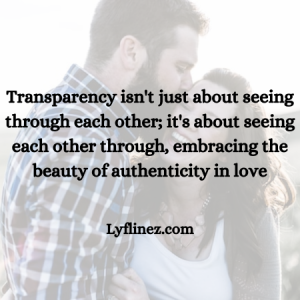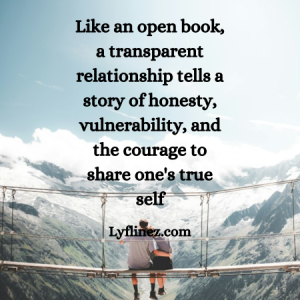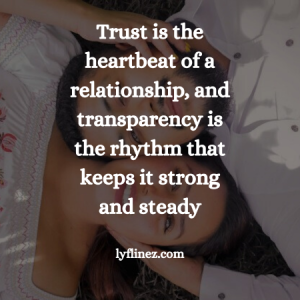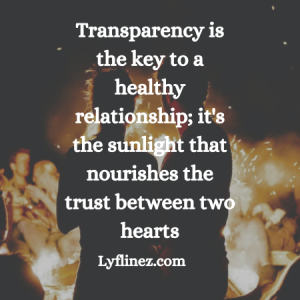The key to a healthy and thriving relationship lies in the openness and honesty we share with our partners. Transparency in a relationship goes beyond mere communication; it’s about baring our souls, fears, and joys to someone we hold dear. Transparency in a relationship is like sunlight – it allows love to grow and thrive.
It’s more than just sharing daily happenings; it’s about being open and honest, creating a foundation of trust between partners.
When you’re transparent, you’re letting your partner see the real you, flaws and all. This vulnerability is what strengthens the bond, making your connection more authentic and resilient.
The benefits of transparency are immense – from building trust to fostering a sense of security. It’s the glue that holds a relationship together through thick and thin.
In this article, I’ll explore the various dimensions of transparency, its benefits, and how it shapes the dynamics of romantic relationships.
What Does It Mean “Transparency In A Relationship”
Being transparent in a relationship is like being open and honest with each other.
It’s about sharing your thoughts, feelings, and stuff that’s going on in your life without hiding anything.
It’s like having clear windows instead of foggy ones, so you both can see what’s going on inside. Just keep it real and let your partner know what’s up.
Imagine you and your partner are on the same page of a book, and that book is your relationship.
Transparency is like making sure you’re both reading the same words, not skipping any paragraphs, and not adding any mystery chapters. You lay it all out there, good and bad.
It builds trust because you know you’re getting the real deal from each other.
No secrets, no hidden agendas. It’s about being vulnerable and letting your partner in on your fears, dreams, and everything in between.
It’s not always easy, but it’s like the glue that holds a strong relationship together.
When you’re transparent, you’re saying, “This is me, flaws and all, and I trust you enough to share it.

Why Transparency Matters In A Relationship
Transparency in relationships is like the backbone of a healthy relationship because it fosters trust, understanding, and genuine connection between partners.
When you’re transparent, you’re essentially laying the foundation for an honest and open communication channel.
This means sharing your thoughts, feelings, and experiences, even the not-so-glamorous ones, with your partner.
It allows both individuals to be fully seen and understood, creating a sense of intimacy that goes beyond the surface.
By being transparent, you’re also demonstrating vulnerability, which is crucial for building emotional bonds.
It enables partners to support each other through challenges and celebrate successes together.
Without transparency, doubts and misunderstandings can creep in, eroding the trust that holds a relationship together.
When both individuals are open about their intentions, desires, and concerns, it helps in navigating the complexities of a relationship more smoothly.
Transparency lays the groundwork for a strong and resilient connection, fostering a deeper understanding of one another and promoting a sense of security and honesty that is fundamental for a lasting and fulfilling relationship.
Radical transparency
It takes the concept of transparency in a relationship to a deeper level. It involves being exceptionally open and candid, often sharing even the most sensitive or uncomfortable information.
This approach aims to eliminate hidden agendas, foster a culture of complete honesty, and build trust through full disclosure.
In a context beyond personal relationships, it has been applied in organizational settings and business practices.
The idea is to share almost all information, including financial details, decision-making processes, and even salaries, with all members of the organization.
The belief is that by providing everyone with access to the same information, a more egalitarian and accountable environment can be established.
In personal relationships, practicing radical transparency could mean sharing not only positive aspects of one’s life but also openly discussing fears, doubts, and potential challenges.
It involves breaking down traditional barriers to communication and being unreservedly honest about one’s thoughts and feelings.
It can promote a high level of openness and trust, it’s important to consider the context and the comfort levels of all parties involved.
Striking the right balance between honesty and tact is crucial to ensure that radical transparency contributes positively to the relationship rather than causing unnecessary discomfort or harm.
It may not be suitable for everyone or every situation, so individuals should assess their comfort levels and the dynamics of their relationships before embracing such an approach.

Benefits Of Transparency In A Relationship
transparency in a relationship is a dynamic and multifaceted aspect that contributes significantly to the depth, resilience, and overall health of the partnership.
Builds Trust:
Transparency is like the mortar that binds the bricks of trust in a relationship. It involves not just honesty but a consistent pattern of openness. When partners share their thoughts, feelings, and even uncertainties, it establishes a trustworthy environment where both individuals can rely on the authenticity of the other.
Enhances Communication:
Transparency acts as a catalyst for effective communication. It goes beyond just conveying information; it involves active listening and understanding. Transparent partners create an atmosphere where they can openly discuss their needs, expectations, and concerns, leading to a more profound connection.
Strengthens Emotional Connection:
True transparency involves sharing the deeper aspects of oneself—the fears, dreams, and insecurities. This vulnerability forms the bedrock of a more profound emotional connection—partners who feel secure enough to be transparent experience a closeness that goes beyond surface-level interactions.
Promotes Security:
In a transparent relationship, there’s a reduced sense of insecurity. Both partners know what to expect from each other because they openly communicate their intentions, plans, and feelings. This certainty contributes to a stable and secure emotional foundation.
Prevents Misunderstandings:
Transparency acts as a preventive measure against misunderstandings. By openly discussing thoughts and intentions, partners can avoid misinterpretations that often lead to unnecessary conflicts. Clear communication helps in aligning expectations and understanding each other’s perspectives.
Encourages Mutual Growth:
Transparent partners actively support each other’s personal growth. By sharing aspirations, challenges, and goals, they create a supportive environment for mutual development. This collaborative approach strengthens the bond as both individuals contribute to each other’s success.
Builds a Culture of Honesty:
Transparency isn’t just a sporadic sharing of information; it’s a commitment to honesty as a core value in the relationship. Partners in a transparent relationship cultivate a culture where truthfulness is prioritized, fostering an environment of integrity and trust.
Facilitates Conflict Resolution:
In times of conflict, transparent communication becomes a crucial tool for resolution. Partners can express their concerns openly, listen actively, and work together to find solutions. Transparency turns conflicts into opportunities for understanding and growth rather than sources of contention.
Strengthens Accountability:
A transparent relationship establishes a sense of accountability. Each partner is accountable for their actions, and the openness about choices and behaviors encourages responsible behavior. This mutual accountability contributes to a sense of shared responsibility for the relationship’s well-being.
Creates a Sense of Unity:
Transparency fosters a shared understanding of the relationship’s dynamics. When both partners are transparent, they’re more likely to be on the same page regarding values, goals, and expectations. This shared vision creates a sense of unity and partnership.
Fosters Long-Term Stability:
The benefits of transparency extend to the long-term stability of the relationship. The trust and understanding developed through consistent openness provide a robust foundation for enduring challenges and evolving together.
Transparency in a relationship brings about a multitude of benefits, creating a healthy and supportive environment where both partners can thrive individually and as a couple.

How To Develop Transparency In A Relationship
Developing transparency in a relationship is a gradual process that involves open communication, trust-building, and a commitment to honesty. Here’s a detailed guide on how to foster transparency in your relationship:
1- Establish Open Communication:
Active Listening: Active listening involves not just hearing words but understanding the emotions and intentions behind them. It means giving your partner your full attention, making eye contact, and responding thoughtfully to what they’ve shared.
Encourage Expression: Foster an environment where your partner feels safe expressing themselves. Avoid judgment and criticism. Instead, show genuine interest in what they have to say, creating a space where open communication is valued.
2- Build Trust:
Consistency is Key: Trust is built through consistent behavior. If you consistently do what you say you’ll do, your partner will feel secure in relying on your words.
Fulfill Promises: If you make promises, make a concerted effort to fulfill them. This not only builds trust but also demonstrates your commitment to the relationship.
3- Share Your Thoughts and Feelings:
Vulnerability Matters: Vulnerability is the key to deepening emotional connections. It involves sharing your authentic self, including your fears, dreams, and insecurities. When both partners are open and vulnerable, it creates a strong emotional bond.
Express Emotions Honestly: Transparency in emotions means being open about how you feel. If you’re happy, share your joy. If you’re upset, express your concerns. This prevents emotional distance and encourages understanding.
4- Be Honest About Expectations:
Discuss Expectations: Communicate your expectations from the relationship. This includes discussing short-term and long-term goals, individual aspirations, and what you both envision for the future.
Address Concerns Promptly: Don’t let concerns linger. Promptly address issues that bother you, fostering an environment where both partners feel comfortable discussing difficult topics.
5- Share Decision-Making:
Involve Each Other: Decision-making is a shared responsibility. Whether it’s major life decisions or day-to-day choices, involving your partner ensures that both perspectives are considered.
Explain Your Choices: When making decisions independently, explain your thought process. This transparency helps your partner understand your reasoning, promoting a sense of inclusion.
6- Learn from Conflict:
Use Conflicts as Opportunities: View conflicts as opportunities for growth rather than obstacles. Conflict can bring hidden issues to the surface, allowing for open discussions and resolutions.
Reflect and Improve: After conflicts are resolved, take time to reflect on what can be learned. Use these reflections to improve communication and prevent similar issues in the future.
7- Respect Privacy Boundaries:
Establish Boundaries: Clearly define and communicate personal space and boundaries. Discuss what aspects of your lives are open for sharing and where privacy is valued.
Communicate About Boundaries: Regularly check in with each other regarding privacy expectations. Open communication ensures that both partners feel respected and comfortable within the established boundaries.
8- Celebrate Achievements and Challenges:
Share Successes: Celebrate your individual and shared successes. Sharing positive experiences creates a sense of shared accomplishment and joy.
Face Challenges Together: When challenges arise, face them as a team. Confronting challenges together strengthens the bond and encourages transparency during difficult times.
9- Seek Professional Help if Needed:
Counseling or Therapy: If communication challenges persist, consider seeking the assistance of a relationship counselor. Professional guidance can provide a neutral space for open discussions and offer tools for improving transparency.
10- Continuously Work on the Relationship:
Adapt and Evolve Together: Recognize that relationships evolve, and so should your commitment to transparency. Continuously assess and adapt to changes, and be willing to grow together through ongoing communication and understanding.
Remember, developing transparency is a dynamic process that requires patience, effort, and a genuine commitment from both partners to create a relationship built on openness and trust.

Further Readings
- How To Stop Wanting A Relationship So Badly: 20 Practical Tips
- Why Am I So Turned Off By My Husband – Reasons & Strategies
- How He Treats You Is How He Feels About You – Is It True?
Challenges And Complications: Lack Of Transparency In A Relationship
Lack of transparency in a relationship can lead to various challenges and complications. Here’s a detailed exploration of the consequences and signs of a lack of transparency:
Erosion of Trust:
The most significant impact is the erosion of trust between partners. When one or both individuals are not transparent, doubts and suspicions can arise, damaging the foundation of the relationship.
The constant questioning, secrecy, and feeling of being left in the dark are signs that trust may be compromised due to a lack of transparency.
Communication Breakdown:
Transparency is closely tied to effective communication. Without openness, there’s a breakdown in the sharing of thoughts, feelings, and important information.
Partners may feel misunderstood, conversations become superficial, and there’s a lack of depth in discussions about personal or relationship matters.
Increased Conflict:
A lack of transparency often leads to misunderstandings and misinterpretations. Unresolved issues can escalate into conflicts, as partners may not fully understand each other’s perspectives.
Frequent arguments, unresolved disputes, and a pattern of recurring conflicts may indicate underlying communication issues.
Emotional Distance:
Without transparency, emotional intimacy can suffer. Partners may become emotionally distant as they withhold their true feelings and thoughts.
Feeling disconnected, a lack of shared emotional experiences, and an overall sense of emotional loneliness are signs that transparency is lacking in the relationship.
Secrets and Hidden Agendas:
Lack of transparency often leads to the harboring of secrets or hidden agendas. This can create a sense of betrayal when undisclosed information comes to light.
Discovering undisclosed information, frequent surprises that were kept secret, or a sense that your partner is not fully sharing their life are indicators of hidden agendas.
Individual Growth Stagnation:
When partners are not transparent about their personal goals and aspirations, it can hinder individual growth. The relationship may become a constraint rather than a supportive environment for personal development.
Feeling stuck, unfulfilled personal aspirations and a lack of support for individual pursuits are signs that transparency is lacking in the context of personal growth.
Difficulty Resolving Issues:
Transparency is crucial for resolving conflicts and addressing relationship issues. Without open communication, issues may linger and remain unresolved.
Recurring problems, a sense of frustration due to unresolved issues, and a feeling that communication breakdowns hinder conflict resolution are indicators of a lack of transparency.
Inability to Plan for the Future:
Planning for the future requires shared goals and a clear understanding of each other’s aspirations. Lack of transparency can hinder the ability to plan for the long term.
Avoidance of discussions about the future, uncertainty about shared goals, and a feeling of being unsure about the direction of the relationship may indicate a lack of transparency.
Diminished Intimacy:
Intimacy relies on emotional closeness, which is fostered through transparent communication. Without openness, intimacy may diminish.
Decreased physical and emotional intimacy, a sense of detachment during intimate moments, and a feeling of emotional coldness are signs that transparency is lacking.
Overall Relationship Dissatisfaction:
The culmination of the above factors often leads to overall dissatisfaction with the relationship. When transparency is lacking, the relationship may feel unfulfilling and unsatisfactory.
A general sense of unhappiness, questioning the longevity of the relationship, and contemplating the overall health of the partnership are signs of dissatisfaction due to a lack of transparency.
Addressing a lack of transparency involves open communication, building trust, and fostering an environment where both partners feel safe and encouraged to share their thoughts and feelings. It requires a joint commitment to honesty and openness to strengthen the foundation of the relationship.
What To Do If You Fail To Make Your Relationship Transparent
Begin by reflecting on your communication patterns, considering areas where transparency may be lacking or where misunderstandings commonly arise.
Identify the barriers that contribute to this lack of openness, whether they stem from fear of judgment, past experiences, or other factors.
Initiate honest conversations with your partner, expressing your desire for more transparency.
Encourage them to share any concerns or fears that might be hindering open communication.
Create an environment that is judgment-free, where both partners feel safe expressing themselves.
Practice active listening, aiming to understand not just the words but also the emotions and intentions behind your partner’s communication. Cultivate a reciprocal sharing of thoughts and feelings.
Lead by example and share your vulnerabilities.
Demonstrating openness about your own experiences can encourage your partner to do the same. Be patient and understanding, recognizing that building transparency takes time.
Avoid placing undue pressure on yourselves.
Establish clear expectations regarding transparency in your relationship. Discuss what information is important to share and establish boundaries, creating a shared understanding.
If communication challenges persist, consider seeking the assistance of a relationship counselor or therapist. A neutral third party can provide guidance and tools for improving communication.
Acknowledge and learn from past mistakes. If there have been instances of dishonesty or a lack of transparency, use them as opportunities for growth and commit to building a more transparent and trustworthy future.
Encourage joint decision-making to foster a sense of collaboration and shared responsibility. Celebrate moments of openness and honesty in your relationship, reinforcing a commitment to transparency.
Building transparency is a continuous process that requires commitment from both partners. Open communication, understanding, and a willingness to address and overcome challenges are essential for creating a more transparent and fulfilling relationship.
Conclusion
Transparency in a relationship is the cornerstone of a healthy and fulfilling connection between partners. It involves open and honest communication, the sharing of thoughts and feelings, and the creation of an environment where both individuals feel safe expressing themselves without fear of judgment.
The benefits of transparency are profound, as it builds trust, strengthens emotional connections, and fosters a sense of security within the relationship. The ability to be vulnerable and share both joys and challenges contributes to a deeper understanding between partners, creating a solid foundation for long-term stability.
However, when transparency is lacking, the consequences can be significant. Erosion of trust, breakdowns in communication, and increased conflict may arise, leading to emotional distance and overall dissatisfaction in the relationship.
Addressing a lack of transparency requires self-reflection, open conversations, and a commitment from both partners to actively work towards fostering a more transparent and honest connection. It is a continuous journey that involves patience, understanding, and a willingness to learn from past mistakes.
Ultimately, a transparent relationship is one where both individuals feel seen, heard, and valued. It is a partnership built on openness, trust, and mutual respect, creating a strong and resilient bond that can withstand the tests of time and challenges that life may bring.
F.A.Qs
Why is transparency important in a relationship?
Transparency is crucial in a relationship because it builds trust, fosters open communication, and creates a sense of security between partners. It allows individuals to be authentic, share their thoughts and feelings, and promote a deeper emotional connection.
What are common signs that a relationship lacks transparency?
Signs of a lack of transparency in a relationship include constant questioning, emotional distance, unresolved conflicts, and feeling left in the dark. Secrecy, hidden agendas, and a general sense of dissatisfaction can also indicate transparency issues.
How can I improve transparency in my relationship?
Improving transparency involves initiating open and honest conversations with your partner. Practice active listening, share your vulnerabilities, and establish clear expectations about communication. Create a judgment-free environment, be patient with each other, and seek professional guidance if needed.
What should I do if I’ve breached transparency in my relationship?
If you’ve breached transparency, acknowledge the mistake, take responsibility for your actions, and communicate openly with your partner. Be willing to learn from the experience, express your commitment to rebuilding trust, and work together to establish a more transparent and honest foundation for the future.
